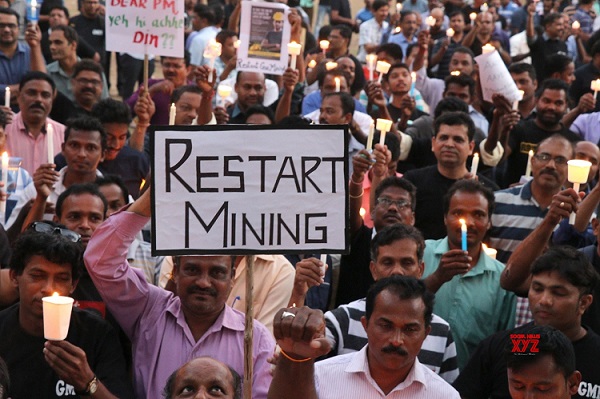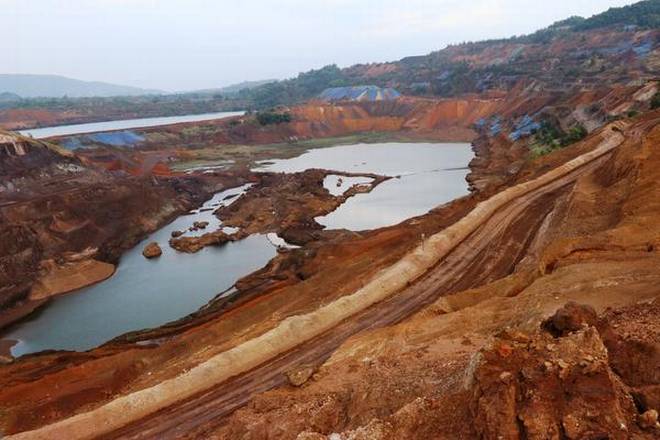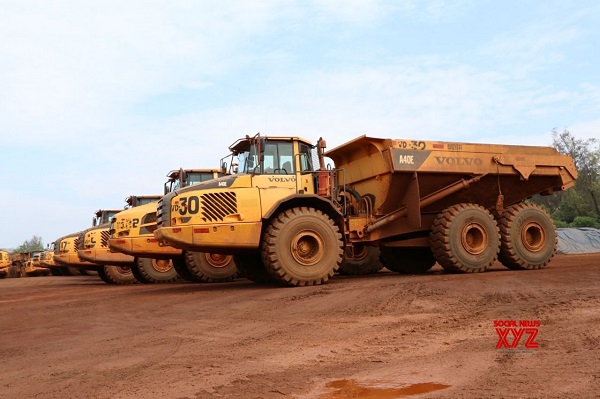
On paper, mining in Goa has been closed for exactly two years. In reality, the crisis has been tossed around — like a ping pong game — for almost seven years. Consider the latest case where the Supreme Court recently allowed the miners to transport nearly 10 million tonnes of iron ore to the ports for export. It will bring revenues worth Rs 3500 crore and help the beleaguered state government fill a portion of its coffers.
But the big question haunting the miners is: Where are the trucks to transport the ore and, more importantly, does the markets need such low-quality ore?
Worse, even if the trucks are procured from outside the state and put into work, is there a guarantee that work will start soon?
Frustrated at the state of affairs in the Goa mining sector, representatives of 40 village Panchayats recently petitioned the state government and the Centre to take action against those not in favour of mining. In their petition, they argued that Goa’s loss is someone’s gain.

And what is interesting is that the biggest beneficiary of the Goa shutdown has been two mining companies from faraway Australia, among them Fortescue Metals Group (FMG) — a public listed company — which have taken over the Goan orders and sending their low-grade iron ore to China. New Delhi’s loss, in other words, is Beijing’s gain.
So what do the miners in Goa do? They wait, wait and wait. A crucial hearing in the Supreme Court next Monday, February 10th , 2020 could solve the state’s long pending mining crisis. All eyes are on the apex court.
The Goa mining crisis is the perfect case of one step forward, two steps backward. Many times, lies have overpowered facts, and turned them into fiction. Consider the point made by the Retired Justice Shah Commission that illegal mining was spread over 550 hectares in Goa and caused a whopping loss of Rs 35,000 crores.
After many court cases, now the actual loss is yet to be computed — I mean a definitive figure — and the area now rests at 5 hectares. In short, the Supreme Court dismissed the Shah Commission findings and asked the state government to assess the losses. The NGOs — there are over 1000 and more in Goa — argued they wanted a six member committee supervised by the country’s apex court. The committee was formed with as many as four members who, reportedly, were heavily leaned towards the NGOs. And when the very committee said the matter should be handled by the state government, the NGOs argued that they did not want the report.

Worse, arguments against miners are now not revolving around environmental damage that was once hyped across India. Now, the arguments revolve around mining acts and tweaking of the same as demanded by the miners and opposed by the NGOs, led by Goa Foundation. Slowly, and steadily, the NGOs have lost their cases and causes, only to file similar appeals in another court.
“We are deeply, deeply anguished at the disturbing trends in Goa. Liabilities are increasing by the day,” says Ambar Timblo, president, Goa Mineral Ore Exporters Association (GMOEA).
Timblo said in an interview in the Indian Capital that it is taking many, many months for the mining companies to counter what he called was blatant lies of the NGOs, and crucial time is lost. “We have got permission to ship the ore now. But for how long? It is like getting an appointment letter for three months with an uncertain future. We hope to get some clear answers from the Supreme Court.”
Timblo said the GMEOA has formulated a three point strategy and wanted New Delhi to react on the same. The three factors listed by the mining body include resumption of mining, judicious implementation of projects under funds collected and why dump sale of iron ore is actually impracticable because of market requirement of better quality ores.
The central government needs to listen and take action on the three-point agenda of the miners.
“Goa mining has a history of several decades and contributed immensely to the socio-economic upliftment of the communities and has contributed a major share in the state revenue. Now, the unemployment rate is almost 35% in the state (highest in India),” says Sauvick Mazumdar, secretary, GMOEA.
Reports emerging from Goa, say miners out of job and cash for nearly two years are on the verge of a total collapse. There could soon be a civil unrest, say reports reaching the national capital.

The figures are horrifying. An estimated 300,000 miners are without salaries ever since the Supreme Court shut down iron ore mining in the coastal state. Another 100,000 people involved in ancillary business have been severely impacted. Mining was the largest employment generator in Goa.
“We have a very uncertain future,” Nilesh Cabral, minister in the Goa government, said in an interview. The minister said he fears unrest among the miners, without jobs for almost 22 months. “Shops have closed, trucks have disappeared, many high-value machines have gathered rust. This is very, very depressing. We want the Centre and the Supreme Court to intervene…We do not know what will happen if the miners turn violent and hit the streets. This is India’s biggest human crisis.”
Cabral said it is unfortunate that mining has been banned in Goa not because of environmental or health concerns but because of the interpretation of the laws: Extension of leases has been disallowed without an alternative solution in mind.
Many support Cabral’s point of view.
Putti Gaonkar, a leader among the miners, says the ban has had a far reaching collateral damage and shaved off a large portion from Goa’s GDP ever since mining stopped.
“We did everything needed, everything within our control. We went to Delhi and represented our case at the Prime Minister’s Office (PMO) last year. But nothing happened. Hundreds have lost their jobs, hundreds have seen their salaries halved, and many are just living on one meal a day. We are in a horrible, horrible condition. Those who pushed us out of jobs are sitting happy, their lives have not been impacted,” said Gaonkar, currently president of the Goa Rajya Kamgar Mahasang, a state level federation of 21 trade unions in Goa.
Worse, the state government has to rely on Sovereign Bond sale to meet its salary commitments to its employees. Shutting down of mining operations has caused a 40% slide in individual incomes, claim recent studies.
“India is waking up to the demands of students, no one cared for us when we sat on the footpath near Parliament for over a week. Goans are peaceful people, we are still peaceful. But how long?” asked Gaonkar.
Gaonkar should know. Intelligence reports generated by cops in Goa say there could soon be a spike in social unrest and crimes, which—in turn—could spell trouble for Goa’s tourism economy. This is not good news because the coastal state’s economy has been, so far, characterized by friendly service and a self-restrained law and order.
The Supreme Court will soon hear a petition of Vedanta Limited on its plea to extend its iron ore mining lease for 50 years, from 1987 to 2037, citing the Mines & Minerals (Development & Regulation) Act of 1957. Highly placed sources told this reporter the mining crisis was among issues listed for Prime Minister Narendra Modi, who met a host of industrialists to discuss ways to boost demand and jobs, and growth in the country. Vedanta chairman and promoter Anil Aggarwal was also present in the meeting.
The Supreme Court cancelled 88 mining leases in Goa on 7th February 2018 and ordered fresh mining leases and fresh environment clearances. The iron ore mines were shut following a petition by the Goa Foundation.
Gaonkar said before the first ban in 2012, mining contributed 25% to the state economy while effectively occupying only around 5% area in the state. After the ban, the contribution is less than 1%. Since mining was 100% export oriented, forex losses are significant, currently standing at a whopping $10 billion.
Supportive infrastructure comprising equipment suppliers, logistics and ancillary industry and the very crucial transport sector with trucks, barges, and jetties, have floundered. As per current estimates, more than 12,000 trucks and 150 barges and ancillary units are at a standstill.
Experts say Goa’s case is unique because it is the only state, which has a logistical arrangement for movement of iron ore from mines to ports through trucks, jetties and barges. In other states, where mining takes place, the primary means for transporting the ore are railway wagons. And the wagons are not always available because Indian Railways is on a perennial short supply. Besides, there are demands for wagons from the coal mining companies as well. So the advantage Goa had for being a unique mining state is now lost.
This is one side of the story. The other side is very horrifying.
Families of the miners have almost exhausted their meagre savings and have been subsisting on loans and doles from friends and well-wishers. Banks and NBFCs in Goa are heading for a slide. When mining was continuing, these very institutions eagerly extended credit lines because of stable collateral.
But in the absence of mining, the ability of miners to repay has vanished. This, in turn, has triggered a huge NPA crisis in the state. The miners, very sadly, are saddled with no hope, no cash. The owners of trucks and mining equipment are being hounded by banks for recovery of loans, which they cannot repay. Outstanding loans now standing at almost Rs 200 crore, 30% of which is from the co-operative banks. The late Chief Minister, Manohar Parrikar, had promised to waive it off. But it has not happened.
“We feel sad when we look at the students’ agitation and the way the nation, its politicians are reacting to it. There is a sense of urgency to it. I want to tell the students that their agitation is for the idea of India. Our idea of India is also in our hearts, perfectly in place. But hunger is important,” said Gaonkar.
